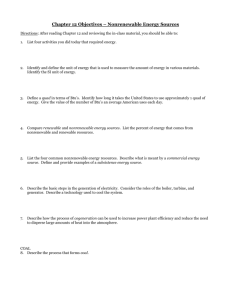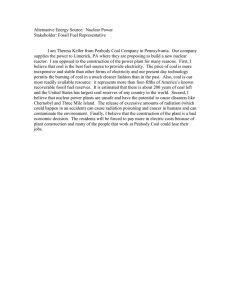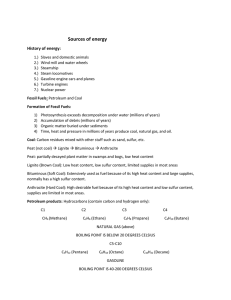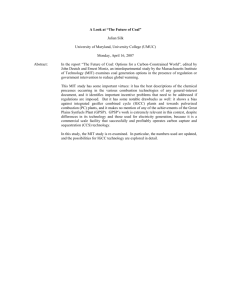Statement of David Garman Under Secretary of Energy Before the
advertisement
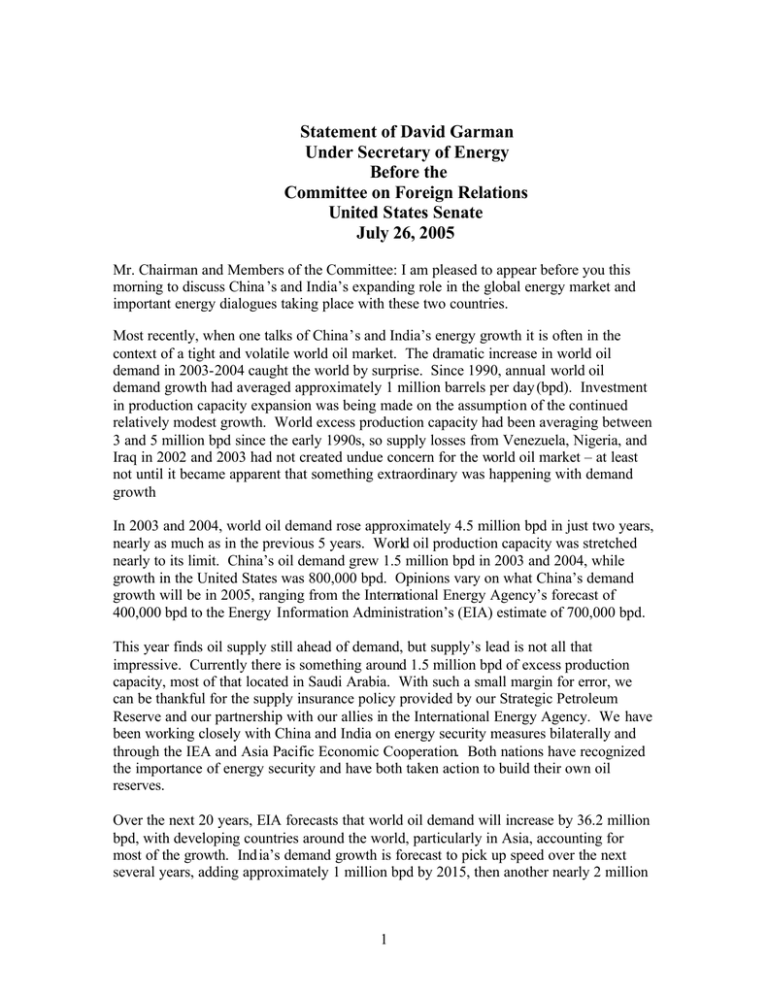
Statement of David Garman Under Secretary of Energy Before the Committee on Foreign Relations United States Senate July 26, 2005 Mr. Chairman and Members of the Committee: I am pleased to appear before you this morning to discuss China ’s and India’s expanding role in the global energy market and important energy dialogues taking place with these two countries. Most recently, when one talks of China’s and India’s energy growth it is often in the context of a tight and volatile world oil market. The dramatic increase in world oil demand in 2003-2004 caught the world by surprise. Since 1990, annual world oil demand growth had averaged approximately 1 million barrels per day (bpd). Investment in production capacity expansion was being made on the assumption of the continued relatively modest growth. World excess production capacity had been averaging between 3 and 5 million bpd since the early 1990s, so supply losses from Venezuela, Nigeria, and Iraq in 2002 and 2003 had not created undue concern for the world oil market – at least not until it became apparent that something extraordinary was happening with demand growth In 2003 and 2004, world oil demand rose approximately 4.5 million bpd in just two years, nearly as much as in the previous 5 years. World oil production capacity was stretched nearly to its limit. China’s oil demand grew 1.5 million bpd in 2003 and 2004, while growth in the United States was 800,000 bpd. Opinions vary on what China’s demand growth will be in 2005, ranging from the International Energy Agency’s forecast of 400,000 bpd to the Energy Information Administration’s (EIA) estimate of 700,000 bpd. This year finds oil supply still ahead of demand, but supply’s lead is not all that impressive. Currently there is something around 1.5 million bpd of excess production capacity, most of that located in Saudi Arabia. With such a small margin for error, we can be thankful for the supply insurance policy provided by our Strategic Petroleum Reserve and our partnership with our allies in the International Energy Agency. We have been working closely with China and India on energy security measures bilaterally and through the IEA and Asia Pacific Economic Cooperation. Both nations have recognized the importance of energy security and have both taken action to build their own oil reserves. Over the next 20 years, EIA forecasts that world oil demand will increase by 36.2 million bpd, with developing countries around the world, particularly in Asia, accounting for most of the growth. Ind ia’s demand growth is forecast to pick up speed over the next several years, adding approximately 1 million bpd by 2015, then another nearly 2 million 1 bpd by 2025. During that period, the U.S. is also expected to add several million bpd of growth. World Oil Demand Growth 30 2005 2015 27.93 2025 24.67 25 20.9 million barrels per day 20 14.73 15 15.08 15.71 12.79 10.66 10 9.2 8.36 6.98 6.1 5.84 5.45 5.72 5.29 5 3.48 2.25 0 U.S. W. Europe China Japan India Other Asia Source: Energy Information Administration Annual Energy Outlook 2005 Rising demand has left major consuming countries such as the United States, China, and India with the shared goals of diversifying and expanding the oil supply sources available to the world market. Both China and Ind ia have attended the recent meetings of International Energy Agency member-country energy ministers in Paris where a key topic for discussion was how to create a more stable and transparent framework for ensuring adequate and timely investment. What is clear is that all countries will have to invest heavily in energy supply, diversification, energy efficiency, and infrastructure expansion in order to meet the world’s growing demand for energy to sustain economic and social development. Energy in China and India to 2025 Robust economic growth has led to the steep increase in energy use in the developing countries of Asia, particularly China and India. While the world as a whole will see economic growth of 3 percent annually over the next 20 years, developing Asia will see its economy expand at a rate of 5.1 percent. To fuel its economic growth, China will see its overall energy demand increase by 3.5 percent per year, while India will follow at 3.2 percent per year. In addition to the expected growth in oil consumption China and India are expected to see among the fastest growth in natural gas use worldwide, increasing by an average annual rate of 6.9 percent and 4.8 percent, respectively, between 2001 and 2025. Gas generation 2 is seen by many as a desirable option for electricity, given its relatively-short deployment timeline, efficiency relative to other energy sources, and the fact that it burns more cleanly than either coal or oil. Although natural gas production is expected to increase in both of these countries, natural gas imports are expected to grow faster. In 2001, India and China produced sufficient natural gas to meet domestic demand, but by 2025, gas production in these two countries will only account for around 60 percent of demand. The growing dependence on imports occurs despite efficiency improvements in both the consumption and the production of natural gas. Coal will continue to dominate the energy markets of both India and China, accounting for 51 percent and 64 percent respectively of total energy consumption in both countries. While the share of coal in total energy is expected to decline, coal will still account for 41 percent in India and 56 percent in China by 2025. These two countries alone account for 67 percent of the total expected increase in coal use worldwide. These levels of coal consumption are major environmental and infrastructure concerns for both countries. The largest increase in nuclear generation is expected for the developing world, where consumption of electricity from nuclear power increases by 4.1 percent per year between 2001 and 2025. Developing Asia, in particular, is expected to see the largest increment in installed nuclear generating capacity over the forecast period, accounting for 96 percent of the total increase in nuclear power capacity for the developing world as a whole. Of over 50 gigawatts of additional installed nuclear generating capacity projected for developing Asia, over 30 gigawatts are projected for China, 15 for South Korea, and 6 for India. India has stated that they would like to have a significantly larger share for nuclear power. While India is a nonsignatory of the Nuclear Nonproliferation Treaty, the recent U.S.-India civil nuclear cooperation agreement will in the coming years likely increase their ability to access civilian nuclear technology. Consumption of electricity from hydropower and other renewable energy sources is expected to grow by 1.9 percent per year over the projection period. Much of the growth in renewable energy use is expected to result from large-scale hydroelectric power facilities in the developing world, particularly among the nations of developing Asia. China, India, and other developing Asian countries are constructing or planning many new, large-scale hydroelectric projects over the forecast period, including China’s 18.2gigawatt Three Gorges Dam project which is scheduled to be fully-operational by 2009. The Indian government has announced plans to add 50 gigawatts of hydroelectric generating capacity by 2012. In China energy intensity is forecast to improve (decline) by 2.4 percent per year between 2001 and 2005, falling from 33,000 Btu per 1997 dollar of GDP to 18,300 Btu per 1997 dollar of GDP. In India, energy intensity declines from 24,600 Btu to 15,400 Btu, an average annual improvement of 1.9 percent. U.S. Energy Policy Responses As we have witnessed and tried to address sharply higher and more volatile energy— especially oil—prices over the last five years, we recognize that we indeed participate in 3 a global, integrated energy market and that we need to address energy supply, demand and infrastructure here at home as well as abroad. As one of its first and highest priorities, this Administration initiated a comprehensive energy policy. The Administration’s policy provides a long-term strategy to increase the supply and suppliers of petroleum, diversify our sources of energy and improve the overall efficiency of energy use. We are pleased that Congress has now moved forward as well. In addressing our need for adequate supplies of oil we are pursuing policies that will enhance domestic oil production, such as exploration of ANWR; add new sources into our energy mix, such as nuclear and increased LNG imports; stimulate the development of alternative fuels, such as ethanol and biodiesel; and increase the efficiency of motor vehicles and appliances. We are promoting more efficient use of the energy we already generate—believing that the next best source of energy is the one we currently waste. Internationally we are working with countries to help them put in place fair and transparent legal regimes that will attract private investment for the development of oil resources while helping the developing countries and growing economies to be more efficient producers and consumers of energy. We began engaging both India and China more than a decade ago. We realized the enormous growth potential in their economies, but at that time saw it more as an opportunity for U.S. energy firms, with their unparalleled excellence in efficient management and effective technology, to gain markets for their equipment, know-how and technology. We still believe that cooperation with China, India and other major developing countries can bring us quicker and better solutions. Longer-term, we believe that breakthrough technologies are needed to address our energy security and environmental challenges. To help achieve these goals, the Department has implemented two major international Presidential initiatives. First, the International Partnership for a Hydrogen Economy (IPHE), which the President envis ions as bringing hydrogen based vehicles to market in a generation to finally ending oil’s chokehold on the transport sector. Second, involving another potentially transformational technology, is the focus of the Department’s Carbon Sequestration Leadership Forum (CSLF). Given their potential technical contributions as well as the importance of their future markets, India and China have been important partners in both initiatives. India has been involved in the CSLF since its inception. China has been an active member of the CSLF and the IPHE since their inceptions. China hosted the IPHE Steering Committee meeting in May 2004 in Beijing, and has offered to host the IPHE Implementation-Liaison Committee meeting in October 2005 in Shanghai. India and China are also active members in the Methane to Markets Partnership, an international initiative headed by the US Environmental Protection Agency, to reduce methane emissions to the atmosphere by recovering the gas and using it for fuel. At the first ministerial meeting for the Partnership, India volunteered to be co-chair and China volunteered to be a vice chair of the Partnership’s Coal Sub-Committee. 4 Energy Cooperation India Growing concerns about energy security have prompted the U.S. and India to launch a new energy dialogue that reflects the transformed strategic relationship between the world’s two largest democracies. Adequate and reliable supplies of energy at reasonable cost are essential to fuel India’s rapidly growing economy. Both the U.S. and India are increasingly reliant upon global oil and natural gas markets to satisfy their energy needs. Both nations depend heavily upon domestic supplies of coal for electric power generation and seek to increase their ut ilization of natural gas, renewable energy and nuclear power as well as pursue energy efficient practices to ensure a balanced and sustainable energy economy that helps preserve a clean environment. The United States and India recognize their mutual interests are best served by working together in a collaborative fashion to ensure stability in global energy markets. DOE’s engagement with India stems back a decade to 1994. Efforts focused on improving the efficiency of India’s coal fired power plants, promoting the use of clean fuels such as natural gas, wind and solar energy, helping establish public-private partnerships in industrial energy efficiency, and improving the investment climate for US energy firms. This cooperation went on hiatus due to the imposition of Glenn Amendment sanctions in 1998 following India’s test of a nuclear weapon. Our energy cooperation revitalized in November 2001 when President Bush and Prime Minister Vajpayee issued a Joint Statement establishing energy as one of five pillars of the Indo-U.S. Economic Dialogue, with the other pillars being trade, investment, commerce and the environment. This enabled the implementation of the President’s National Energy Policy (NEP) Plan’s recommendation that DOE work with India’s Ministry of Petroleum and Natural Gas (MPNG) to enhance domestic oil and gas supply. There followed a number of activities, including: - A “Building Gas Markets in India” conference in 2002. The creation of a Coal Advisory Group in 2002. A study mission on Coal Bed Methane to the US by the Indian Secretaries of Petroleum and Natural Gas, Coal and Labor (January 2003). A visit by the Indian Minister of Petroleum and Natural Gas to a Strategic Petroleum Reserve (SPR) site in mid-2003, followed by a technical seminar on strategic oil storage in Washington for an Indian engineering team. These activities helped promote the deployment of clean energy technologies and fuels, supported reforms in the power sector, enhanced India’s awareness of steps it needed to take to attract foreign investment in the energy sector and bolstered India’s energy security. In regards to energy security, India has announced plans to develop a 5 million ton strategic crude oil reserve. Several locations near Mangalore on the east coast are 5 being considered. The Indian Strategic Petroleum Reserve Ltd. was incorporated on June 16, 2004 to implement this project, which is expected to take about four years to complete. India also supported President Bush’s call for a transformed Indo-U.S. relationship premised upon a new strategic alliance under which energy security and energy cooperation are key factors. In addition to the recent U.S.-India civil nuclear cooperation announcement, this relationship was also reflected in the launch of the new U.S.-India Energy Dialogue on May 31, 2005. It established five working groups along with a steering committee to provide oversight. The goals of the Dialogue are to promote increased trade and investment in the energy sector by working with the public and private sectors to further identify areas of cooperation and collaboration. Building upon the broad range of existing cooperation, it is hoped that this effort will help mobilize secure, clean reliable and affordable sources of energy. The five Working Groups are: Oil and Gas, Coal, Power and Energy Efficiency, New Technologies and Renewable Energy, and Civil Nuclear. We hope they will be successful in developing robust work programs to achieve the objectives of the Dialogue. China The Department of Energy’s engagement with China dates back to immediately after the normalization of diplomatic relations between the U.S. and China. Much of the overall cooperation with China focused on science and technology cooperation includ ing exchange of scientists, training, demonstration programs, and collaborative visits. In 1995 the Department initiated bilateral consultations with China ’s State Planning Commission (a predecessor to the National Development and Reform Commission - NDRC). The range of bilateral technical cooperation includes high energy physics, fusion, peaceful uses of nuclear technologies, fossil energy and energy efficiency. China’s rising energy demand has become a global concern in recent years. Recognizing the strong demand rise as a potential bottle- neck to its economic development, the Chinese government has begun looking deeply into energy policy making, seeking advice from other countries and reviewing energy issue priorities. Conversely, fast developments in Chinese energy demand and supply conditions and energy policymaking system have heightened the need for a concrete mechanism to obtain accurate facts and information on China’s energy policies and plans. DOE and the NDRC have agreed to engage in policy level discussions on a range of energy issues, including energy policymaking, supply security, power sector reform, energy efficiency, renewable energy, and energy technology development options. Through the Energy Policy Dialogue, the Department specifically aims • • To exc hange views with China on each side’s views of current and future national and international energy markets; To better assess the impacts of China’s energy policies on U.S. energy security; 6 • • To offer relevant U.S. experiences (positive and negative) in energy and related environmental policies and regulations to assist Chinese energy economic and environmental policy makers as they develop and revise their policy, legal and regulatory framework; and To mitigate environmental affects of China’s rising fossil energy consumption. The first meeting for Energy Policy Dialogue on June 30 clearly emphasized how the U.S. and China share many common challenges and opportunities as the two largest energy consumers. Another key bilateral energy engagement is the U.S.-China Oil & Gas Industry Forum, established in 1998. US industry continues to be the largest investor in China's petroleum sector and they view the Forum as an important opportunity for facilitating U.S. investment in China’s oil and gas industry. The Sixth Forum meeting in New Orleans, Louisiana, June 28-29, 2005 was attended by over 30 delegates from China, including representatives from the NDRC, PetroChina, Sinopec, CNOOC, SinoChem, and China United Coalbed Methane Corporation. Key topics included Deep water/Off-shore development; Coalbed methane production; U.S. participation in China’s upstream activities; LNG infrastructure development and prospects; and risk management issues for large energy infrastructure projects in China. In addition to these major bilateral initiatives, the Department is actively engaged with China through a number of multilateral frameworks to enhance our energy security objectives. In the Asia Pacific Economic Cooperation (APEC) Energy Working Group, China is an important participant in the Energy Security Action Plan that APEC adopted during the Bangkok Leaders Meeting at the initiative of President Bush. Through International Energy Agency (IEA) workshops, the Department has been encouraging the Chinese government to create or improve a legal framework, price regulation and taxation scheme for the natural gas sector, and advising them in addressing technical challenges as China has embarked upon a major expansion of its gas infrastructure. Also, the Department has steadily encouraged the Chinese government to establish strategic oil stocks. With the opening of the Department of Energy Office in Beijing, which was announced by Secretary Bodman on June 30, the Department will renew its push to seek opportunities to better assess the impacts of China’s energy policies on U.S. energy security, positively affect Chinese energy and economic policymaking, as well as advance commercial opportunities for US industry. IGCC The Committee has expressed an interest in my addressing opportunities for cooperation between the U.S. and India and China on Integrated Gasification Combined Cycle (IGCC) development. Let me say the following about our efforts with both countries in this regard: 7 India - The Department’s National Energy Technology Laboratory is managing a $2.5 million engineering study for India funded by the United States Agency for International Development (U.S.AID). The study is expected to be completed by year end or early next year, but so far initial numbers have indicated the cost of IGCC to be very high relative to the conventional power plant technology. China - In 2003 an “On-Site IGCC Briefing” took place for a delegation from China with the purpose of helping to increase China’s interest and knowledge in U.S. Clean Coal Technologies and promote their acceptance in China’s market place. It is hoped that a study of Chinese gasification experiences slated to start in 2006 might be applicable to future IGCC designs for both the U.S. and Chinese markets. In support from Nexant and the Gas Technology Institute (GTI), DOE/NETL conducted a study of the application of GTI's U-Gas fluidized-bed gasification technology. The history of the operation of the U-Gas technology has demonstrated significant issues that have resulted in limited domestic applications of these systems. The only commercialscale application of the U-Gas technology is at Shanghai Chemical and Coking (SCC) Corporation outside Shanghai, China, which was of similar scale to that being studied. While the U-Gas gasifiers were run by SCC for approximately 5 years, they no longer operate owing to design and operational difficulties. As part of the study, DOE/NETL, Nexant, and GTI engineers visited the SCC facility as well as a second, operating fluidized-bed gasification system in Shaanxi Province that is of a similar design to the GTI technology. During the visits, the NETL team was able to meet with design and operations personnel of the SCC and Shaanxi facilities and discuss their past experience with the U-Gas and U-Gas similar gasifiers. Their extensive knowledge of past plant operations provided insight to critical design parameters. Discussions with plant operators and inspection of the changes made or desired for plant improvement were key to plant design improvements incorporated in the DOE/NETL study. Conclusion Mr. Chairman and members of the committee, let me conclude by acknowledging that economic growth and the inevitable increase in energy demand that it entails is steadily shifting—at the margin—from the traditional industrialized countries, such as the members of the OECD (Organization for Economic Cooperation and Development) to Asia. This transformation, like any other, is creating strains in a number of areas, and energy certainly is foremost among them. But we cannot simply blame China, India and other developing nations for seeking the same levels of affluence that our citizens enjoy. First and foremost the U.S. must address its energy problems at home and in this regard we are happy to see the progress being made by the Conference Committee on the Energy Bill and hope that after four years the country will have comprehensive energy legislation enacted by the end of the summer. Second, we believe that we need to continue to engage countries like China and India in energy dialogues so that we better understand their markets and their motivations, and that we can offer assistance in developing market-based regulatory regimes that lead to greater energy efficiency and opening of their markets to U.S. trade and investment. And finally we are convinced that 8 bilateral and multilateral energy cooperation maximizes everyone’s energy security. Thank you, Mr. Chairman, for the opportunity to address the Committee on this important subject and I am happy to take any questions you or the members may have. 9


